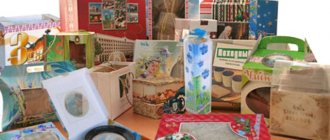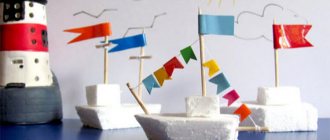SOFTWARE CONTENT:
generalize and clarify children’s knowledge about air; consolidate basic ideas about the sources of air pollution, the importance of clean air for our health, and some rules of environmental safety. Develop thinking, memory, speech, interest in cognitive activity, express an assumption, opinion, justify it. Arouse interest in completing tasks together and create a friendly atmosphere. To instill in children a caring attitude towards the world around them.
EQUIPMENT AND MATERIALS:
emblems /blue, green, red balloons/ according to the number of children, arrangement of equipment in the group, 6 glasses, 3 paper napkins, an aquarium with water, 3 plastic bags, a lump of earth, a piece of brick, a sponge, an easel, an exhibition of drawings on the topic “How a person uses air”, tape recorder, recording of “The Thunderstorm” by Vivaldi, numbers 1,2,3 on stands, pyramids according to the number of children, cup of water, jar of water, 2 drawings: a clean city, a polluted city, colored pencils, landscape sheets, medals.
PRELIMINARY WORK:
conducting a series of classes about air, elementary experiments to get acquainted with the properties of air, research walks, observations, excursions, drawing on the topic “How a person uses air”, memorizing poems about the wind, reading fairy tales.
Children stand in a semicircle in a group room.
Educator:
Guys, tell me what is not visible in the room?
Children:
Air.
Educator:
What do you know about air? /It is invisible, transparent, colorless/.
Educator:
How did you then know that there was air in the room? /If there was no air, we would not be able to breathe/.
- Well done! Now, imagine that you are scientists, and they work in laboratories. We also have three laboratories. We need to divide into three groups, think about how best to do this. /By emblems/.
— Split up? Well done!
Scientists are faced with the following task: to try to detect air in their laboratory using experiments, and then prove it.
I ask air researchers to go to their laboratories /Children disperse, sit at tables, conduct experiments with air, using the prepared equipment and material/.
Educator:
So, let's start the meeting of the academic council. Scientists from Laboratory No. 1 will talk about their discovery.
Child:
“We took a glass and put a paper napkin at the bottom, then, turning the glass with the hole down, we sharply lowered it into an aquarium with water, and then quickly took it out of the water and touched the napkin, it turned out to be dry. This proves that there was air in the glass, which prevented water from entering the glass. And since there is no water, it means she cannot wet the napkin.
Educator:
- Does anyone have other opinions? Congratulations on your opening!
We listen to laboratory number 2.
Child:
— We took a plastic bag and began to twist it from the side of the hole. But as we twisted, we saw that it inflated and became convex. This proves that there is air in the bag, which inflates the bag.
Educator:
— Any other opinions? Well, congratulations to you on the opening!
Educator:
— We listen to the scientists of laboratory No. 3.
Child:
“We took a lump of earth, a piece of brick, a sponge and lowered it all into the water. We noticed that air bubbles appeared in the water. This proves that there is air in the earth, in the brick, in the sponge.
Educator:
— Any other opinions? Congratulations on your opening!
Educator:
- Well done, guys, you proved that air is everywhere around us.
Guys, come to the exhibition of drawings. Look and tell me how people use air? /Children's answers/.
Educator:
- Now close your eyes, listen to the music, /the recording of Vivaldi’s “The Thunderstorm” is playing/ and tell me what it reminded you of? /Rain, thunder, wind/.
Educator:
-Where did the rain come from? /It was the wind that drove the clouds/.
Educator:
-What is wind? /This is air movement/.
Educator:
- Show with your palm how you can feel the wind. /Children wave their palms in front of their faces/.
Educator:
- How do you feel about this? /Coolness, freshness/
Educator:
— The wind in fairy tales was endowed with magical powers, it was compared to a hero, affectionately called a mischief-maker, and people often turned to the wind for help. Why do you think? /Because the wind can fly quickly around the world, can look into any corner of the earth/.
Educator:
- Let's remember the poets' poems about the wind / Children read A.S. Pushkin's poems “The wind walks on the sea”, “Wind, wind, you are mighty!” A. Orlova “The Shepherd Wind”/.
Educator:
— Guys, is wind good or bad for humans?
Educator:
- Why is it good? /Sailboats float, people hang glider, etc./
Educator:
- What's bad? Prove your answer /The game “Good-Bad” is played/.
Educator:
- You know a lot about air, let's hold a competition of experts among scientists. I ask the scientists to restore order in the laboratories and take their places at the tables. / The children clean up the tables, put everything on a separate table, and sit down. /.
Educator:
- So, let's start the competition of experts. I remind you of the rules of the game: I will ask a question, whoever knows the answer must raise his hand. While answering, you cannot interrupt your friend; you can add something if the answer was not complete. For each correct answer, the participant receives a ring chip for his pyramid.
Educator:
- First question. In which fairy tale did the main character fly in and fly away with a fair wind? /"Mary Poppins, goodbye!" P.L. Traversa/.
Educator:
- Second question. What fairy-tale characters flew through the air? /Serpent-Gorynych, Baba Yaga, Carlson, the Elves to whom Thumbelina flew had small wings, she also received such wings, etc./
Educator:
— The third question is a story with an error. Listen carefully and find as many inaccuracies as possible, explain your point of view. The story of the famous traveler Baron Munchausen:
“One day we were sailing across the ocean on a sailing ship. The weather was calm and windless, and our wonderful ship sailed with full sail to distant mysterious shores.” /Children's answers/.
Educator:
— The fourth question is a story with a question.
“One day Katya and her mother were walking down the street and admiring the floating clouds. And suddenly Katya shouted: “Mom, mom, look, a dandelion has grown on the roof of this two-story house. Who put him there?
Educator:
-Who really planted a dandelion there? /Wind/
Educator:
- How could he get there?
Educator:
- Fifth question. What other plants with flying seeds do you know? /Birch, maple, poplar, ash, elm, pine, spruce, linden, reed/.
Educator:
- The sixth question is a story with a question,
“One day, tourists were going on a hike. One of them, named Pyotr Ivanovich, loved butterflies. He watched them everywhere. “Let’s get to the top soon! There are probably so many butterflies, dragonflies and beetles that I have never seen in my life!” - he thought. But the higher and higher the tourists climbed, the butterflies and dragonflies became fewer and fewer. And those that were, mostly crawled on the ground and did not fly. At the very top, no one flew at all. Pyotr Ivanovich was surprised and thought: “Why don’t extraordinary butterflies and bugs live here?
/The higher we rise in the mountains, the stronger the wind becomes. In strong winds, insects cannot fly; the wind blows them away and carries them away.
Educator:
- Seventh question. Name a science that uses air to build its “house”? /Spider-diver; silver spider/.
Educator:
— Eighth question: Why was the plant “tumbleweed” called that way? /Because the wind can tear this plant off the ground and roll it across the field for a long, long time, like a bun./.
Educator:
— Guys, we did an experiment: we took clean water into a plate and put it on the window near the balcony. They also filled a jar with clean water and placed it on an area near the fence on the side of the road. Let's see what happened to the water over the weekend? /She became dirty/.
Educator:
- Why? /Children's answers/.
Educator:
—Which water is purer?
Educator:
— That’s right, in our group the air is relatively cleaner than near the road.
Name other places where there may be dirty air that is dangerous to breathe. /Near factories, next to garages, next to a parking lot, near a road where a lot of cars pass, near garbage dumps that are usually on fire, at a gas station, etc./
Educator:
— Guys, look at these drawings and tell me: what city would you like to live in? Why? Two drawings are exhibited: a clean city: everything is blooming, growing, green nature, etc., the other - a factory chimney is smoking, everything is covered in smoke, etc. /Children's answers/.
Educator:
— Now Anya will read a poem.
Child:
- Let's take care of the planet.
There is no other one like it in the world. We will scatter fires and smoke over her, and we will not let anyone offend her!”
Educator:
“You’re small and you can’t make sure that factory chimneys don’t smoke and there aren’t huge landfills, but you can take care of your health. How? / Do not walk near roads, garages, parking lots, factories, landfills, do not take long walks on a windy, dusty day, etc. /
Educator:
- Well done! Now let’s summarize, let’s count who has more rings on the pyramid. /Children count rings on pyramids/.
Educator:
- Let's all congratulate the winner and be happy for him.
Educator:
— Guys, are you satisfied with your game? /Children's answers/.
Educator:
- Now, if your mood were rated from 1 to 10, what rating would you choose for yourself? /Children's answers/.
Educator:
- Thank you for the game, with today’s game you proved that you are real experts.
Educator:
- Guys, you know so much, but the younger children don’t know this yet, so let’s help them: we’ll come up with and draw signs that will help the kids learn to take care of their health, and after sleep we’ll give it to them and tell them. I came up with this sign: don’t walk near the road. And you come up with your own. /Children in their free time draw special signs warning about the danger of breathing polluted air/.


